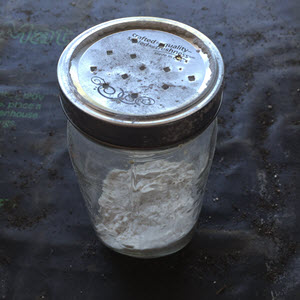Techniques to Stop Grasshoppers from Eating Flowers and Vegetables

In starting our flower farm this year, we had some serious issues out of the gate with our friend the grasshopper. Little did I know that with our heavy rain in spring, combined with years of drought, we had the perfect environment for a plague of the little critters. Imagine my surprise, after the day before, seeing all my seedlings coming up, and the following day thinking someone was playing a joke when they were all gone. Our 50×40 plot was infested with the little fellas. So, here is some research onhow to get rid of grasshoppers in your garden.
- Dusting the plants with flour – I used this one, repeatedly, and it seemed to really help. Supposedly, this gums up the grasshopper jaws and prevents them from eating. The critters eat there weight in plant matter per day, so this will definitely wreak havoc on the population. Word of warning: Only use all-purpose flour. Self-rising and other types have salts which can damage plants. I created a sifter by taking a mason jar and drilling small holes in the top.

Flour to get rid of grasshoppers - Use grasshopper bait – if you are into biological warfare, you can use Nosema locustae protozoa to control the grasshopper population. Most of these products attach the protozoa to wheat germ, and affect this years pests by reducing appetite, and also infect the eggs for next years spawn.
This biological agent affects the digestive system of the grasshopper, and is passed on to larvae and predatory species.
We use this on our farm every year! Click to see on Amazon. - Use garlic spray – grasshoppers hate the smell and taste of garlic, and will avoid plants sprayed with these ingredients. In addition to spray, you can also grow garlic throughout the garden as a natural protective barrier. You can make your own by crushing two bulbs and adding them to water or mineral oil, or you can buy a pre-made solution to get rid of your green grasshopper friends. If you dont want to make your own, you can buy pre-made spray here: Garlic Spray for Grasshoppers

Garlic Spray and Plants to Get Rid of Grasshoppers - Grow other natural repellents – grasshoppers also will avoid cilantro, peas and sweet clover. You can pepper these throughout the garden, along with your garlic, to give grasshoppers a reason to migrate elsewhere for food.
- Chickens – this is one I just recently discover, and I plan to buy a few for next year. If you have the space, chickens will work for you all day to eliminate not only grasshoppers, but also many other garden pests.

Chickens Love to Eat Grasshoppers
I would use several of these and alternate to get rid of grasshoppers from your garden. Below is some additional information on grasshopper habitat and eating habits:
The Grasshopper Diet
As mentioned, grasshoppers are voracious eaters, and will eat grass, leaves and many other types of crops. If you can eliminate these from the surrounding area, it will help minimize their impact on your garden.
The Grasshopper Habit: Hopefully not Your Garden
Grasshoppers are low on the food chain, and prefer to live where they have the best opportunity for survival. They mostly live in low lying open spaces where the food they eat (grass, leaves and other plants) are readily available. The open space provides them an adequate view to see predators, and also gives them the room for a quick escape.
Here are some other great links for controlling the pesky grasshopper:
UNL Guide to Grasshopper Control
UC System Guide to Grasshopper Control
Any other tips or ways you have controlled grasshoppers in your garden? Please comment.















You must be logged in to post a comment.